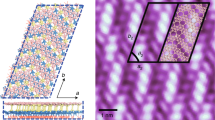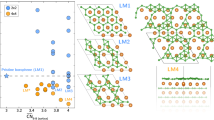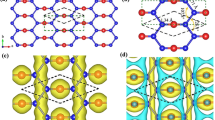Abstract
Synthetic two-dimensional (2D) materials have no bulk counterparts and typically exist as single atomic layers due to substrate-stabilized growth. Multilayer formation, although broadly sought for structure and property tuning, has not yet been achieved in the case of synthetic 2D boron: that is, borophene1,2. Here, we experimentally demonstrate the synthesis of an atomically well-defined borophene polymorph beyond the single-atomic-layer (SL) limit. The structure of this bilayer (BL) borophene is consistent with two covalently bonded α-phase layers (termed BL-α borophene) as evidenced from bond-resolved scanning tunnelling microscopy, non-contact atomic force microscopy and density functional theory calculations. While the electronic density of states near the Fermi level of BL-α borophene is similar to SL borophene polymorphs, field-emission resonance spectroscopy reveals distinct interfacial charge transfer doping and a heightened local work function exceeding 5 eV. The extension of borophene polymorphs beyond the SL limit significantly expands the phase space for boron-based nanomaterials.
This is a preview of subscription content, access via your institution
Access options
Access Nature and 54 other Nature Portfolio journals
Get Nature+, our best-value online-access subscription
$29.99 / 30 days
cancel any time
Subscribe to this journal
Receive 12 print issues and online access
$259.00 per year
only $21.58 per issue
Buy this article
- Purchase on Springer Link
- Instant access to full article PDF
Prices may be subject to local taxes which are calculated during checkout




Similar content being viewed by others
Data availability
All data needed to evaluate the conclusions in the paper are present in the paper and/or the Supplementary Information. Additional data related to this paper may be requested from the authors.
References
Mannix, A. J. et al. Synthesis of borophenes: anisotropic, two-dimensional boron polymorphs. Science 350, 1513–1516 (2015).
Feng, B. et al. Experimental realization of two-dimensional boron sheets. Nat. Chem. 8, 563–568 (2016).
Zhai, H.-J., Kiran, B., Li, J. & Wang, L.-S. Hydrocarbon analogues of boron clusters—planarity, aromaticity and antiaromaticity. Nat. Mater. 2, 827–833 (2003).
Zhai, H.-J., Alexandrova, A. N., Birch, K. A., Boldyrev, A. I. & Wang, L.-S. Hepta- and octacoordinate boron in molecular wheels of eight- and nine-atom boron clusters: observation and confirmation. Angew. Chem. Int. Ed. Engl. 42, 6004–6008 (2003).
Ogitsu, T., Schwegler, E. & Galli, G. β-Rhombohedral boron: at the crossroads of the chemistry of boron and the physics of frustration. Chem. Rev. 113, 3425–3449 (2013).
Ogitsu, T. et al. Imperfect crystal and unusual semiconductor: boron, a frustrated element. J. Am. Chem. Soc. 131, 1903–1909 (2009).
Mannix, A. J., Zhang, Z., Guisinger, N. P., Yakobson, B. I. & Hersam, M. C. Borophene as a prototype for synthetic 2D materials development. Nat. Nanotechnol. 13, 444–450 (2018).
Liu, X., Zhang, Z., Wang, L., Yakobson, B. I. & Hersam, M. C. Intermixing and periodic self-assembly of borophene line defects. Nat. Mater. 17, 783–788 (2018).
Liu, X. et al. Self-assembly of electronically abrupt borophene/organic lateral heterostructures. Sci. Adv. 3, e1602356 (2017).
Liu, X. & Hersam, M. C. Borophene-graphene heterostructures. Sci. Adv. 5, eaax6444 (2019).
Feng, B. et al. Dirac fermions in borophene. Phys. Rev. Lett. 118, 096401 (2017).
Kiraly, B. et al. Borophene synthesis on Au(111). ACS Nano 13, 3816–3822 (2019).
Wu, R. et al. Large-area single-crystal sheets of borophene on Cu(111) surfaces. Nat. Nanotechnol. 14, 44–49 (2019).
Li, W. et al. Experimental realization of honeycomb borophene. Sci. Bull. 63, 282–286 (2018).
Vinogradov, N. A., Lyalin, A., Taketsugu, T., Vinogradov, A. S. & Preobrajenski, A. Single-phase borophene on Ir(111): formation, structure, and decoupling from the support. ACS Nano 13, 14511–14518 (2019).
Tang, H. & Ismail-Beigi, S. Self-doping in boron sheets from first principles: a route to structural design of metal boride nanostructures. Phys. Rev. B 80, 134113 (2009).
Zhang, Z., Yang, Y., Penev, E. S. & Yakobson, B. I. Elasticity, flexibility, and ideal strength of borophenes. Adv. Funct. Mater. 27, 1605059 (2017).
Penev, E. S., Kutana, A. & Yakobson, B. I. Can two-dimensional boron superconduct? Nano Lett. 16, 2522–2526 (2016).
Yang, J. et al. Interfacial properties of borophene contacts with two-dimensional semiconductors. Phys. Chem. Chem. Phys. 19, 23982–23989 (2017).
Huang, Y., Shirodkar, S. N. & Yakobson, B. I. Two-dimensional boron polymorphs for visible range plasmonics: a first-principles exploration. J. Am. Chem. Soc. 139, 17181–17185 (2017).
Zhang, X. et al. Borophene as an extremely high capacity electrode material for Li-ion and Na-ion batteries. Nanoscale 8, 15340–15347 (2016).
Shukla, V., Wärnå, J., Jena, N. K., Grigoriev, A. & Ahuja, R. Toward the realization of 2D borophene based gas sensor. J. Phys. Chem. C 121, 26869–26876 (2017).
Gao, N., Wu, X., Jiang, X., Bai, Y. & Zhao, J. Structure and stability of bilayer borophene: the roles of hexagonal holes and interlayer bonding. FlatChem 7, 48–54 (2018).
Ma, F. et al. Graphene-like two-dimensional ionic boron with double Dirac cones at ambient condition. Nano Lett. 16, 3022–3028 (2016).
Zhou, X.-F. et al. Two-dimensional magnetic boron. Phys. Rev. B 93, 085406 (2016).
Xu, S.-G., Zheng, B., Xu, H. & Yang, X.-B. Ideal nodal line semimetal in a two-dimensional boron bilayer. J. Phys. Chem. C 123, 4977–4983 (2019).
Zhong, H., Huang, K., Yu, G. & Yuan, S. Electronic and mechanical properties of few-layer borophene. Phys. Rev. B 98, 054104 (2018).
Liu, X. et al. Geometric imaging of borophene polymorphs with functionalized probes. Nat. Commun. 10, 1642 (2019).
Hapala, P. et al. Mechanism of high-resolution STM/AFM imaging with functionalized tips. Phys. Rev. B 90, 085421 (2014).
Liu, X., Wang, L., Yakobson, B. I. & Hersam, M. C. Nanoscale probing of image-potential states and electron transfer doping in borophene polymorphs. Nano Lett. 21, 1169–1174 (2021).
Karmodak, N. & Jemmis, E. D. Metal templates and boron sources controlling borophene structures: an ab initio study. J. Phys. Chem. C 122, 2268–2274 (2018).
Zheng, B. et al. Highly effective work function reduction of α-borophene via caesium decoration: a first-principles investigation. Adv. Theory Simul. 3, 1900249 (2020).
Lu, C.-I. et al. Graphite edge controlled registration of monolayer MoS2 crystal orientation. Appl. Phys. Lett. 106, 181904 (2015).
Perdew, J. P., Burke, K. & Ernzerhof, M. Generalized gradient approximation made simple. Phys. Rev. Lett. 77, 3865–3868 (1996).
Blöchl, P. E. Projector augmented-wave method. Phys. Rev. B 50, 17953–17979 (1994).
Kresse, G. & Furthmüller, J. Efficient iterative schemes for ab initio total-energy calculations using a plane-wave basis set. Phys. Rev. B 54, 11169–11186 (1996).
Grimme, S. Semiempirical GGA-type density functional constructed with a long-range dispersion correction. J. Comput. Chem. 27, 1787–1799 (2006).
Krejčí, O., Hapala, P., Ondráček, M. & Jelínek, P. Principles and simulations of high-resolution STM imaging with a flexible tip apex. Phys. Rev. B 95, 045407 (2017).
Acknowledgements
X.L., Q.L., M.S.R. and M.C.H. acknowledge support from the Office of Naval Research (ONR N00014−17-1-2993) and the National Science Foundation Materials Research Science and Engineering Center (NSF DMR-1720139). Q.R. and B.I.Y. acknowledge support from the Electronics Division of the US Army Research Office (W911NF-16-1-0255) and the Robert Welch Foundation (C-1590).
Author information
Authors and Affiliations
Contributions
X.L. and M.C.H. conceived the project. X.L., Q.L. and M.S.R. performed sample preparation and STM/FER/AFM measurements. Q.R. and B.I.Y. designed the models. Q.R. performed the DFT simulations. X.L. provided assistance with model construction. All authors contributed to data interpretation and manuscript writing.
Corresponding authors
Ethics declarations
Competing interests
The authors declare no competing interests.
Additional information
Peer review information Nature Materials thanks Ivan Bozovic and Guy Le Lay for their contribution to the peer review of this work.
Publisher’s note Springer Nature remains neutral with regard to jurisdictional claims in published maps and institutional affiliations.
Supplementary information
Supplementary Information
Supplementary Figs. 1–11.
Rights and permissions
About this article
Cite this article
Liu, X., Li, Q., Ruan, Q. et al. Borophene synthesis beyond the single-atomic-layer limit. Nat. Mater. 21, 35–40 (2022). https://doi.org/10.1038/s41563-021-01084-2
Received:
Accepted:
Published:
Issue Date:
DOI: https://doi.org/10.1038/s41563-021-01084-2
This article is cited by
-
Realization of large-area ultraflat chiral blue phosphorene
Nature Communications (2024)
-
Bilayer borophene: an efficient catalyst for hydrogen evolution reaction
Frontiers of Chemical Science and Engineering (2024)
-
Experimental evidence of surface copper boride
Nano Research (2023)
-
Massive and massless plasmons in germanene nanosheets
Scientific Reports (2022)
-
The birth of bilayer borophene
Nature Chemistry (2022)



